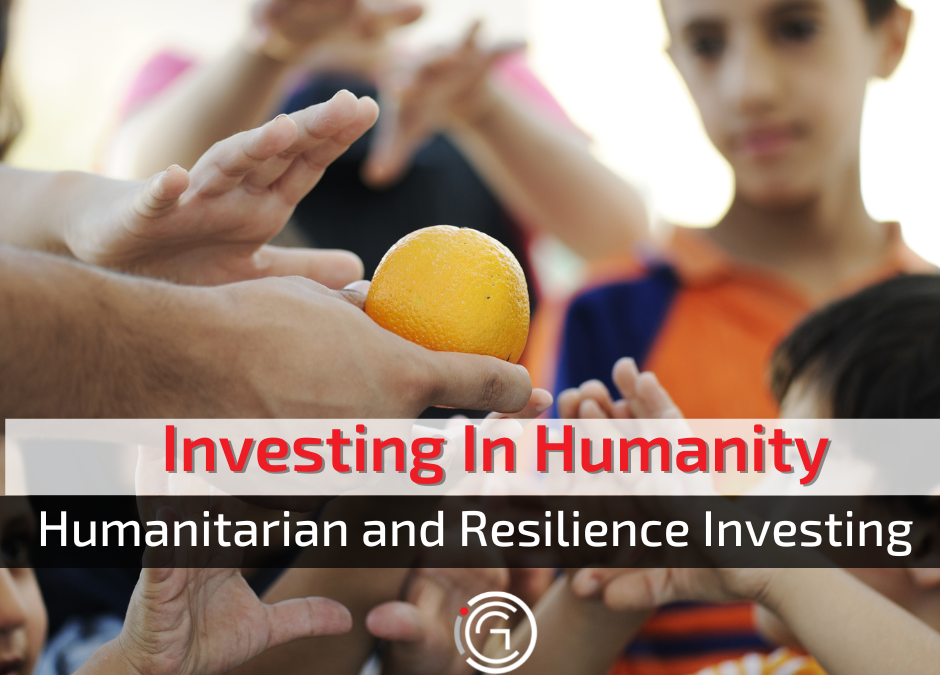Stimulated by the World Economic Forum’s 2019 launch of an initiative to strengthen the resilience of the most vulnerable communities and economies, humanitarian and resilience investing (HRI) has become increasingly popular over the last few years.1 As more humans deal with the effects of war, famine, climate change, and global pandemics, there is a greater need for investment in humanitarian initiatives. What should you know about this new type of investing, and what might be the future of HRI?
What is Humanitarian and Resilience Investing?
When a disaster happens, governments and charities begin working to provide relief to those affected. This relief may include emergency food and shelter, funds to rebuild communities, or temporary relocation programs. With these disasters happening more frequently than ever and existing relief resources stretched thin in the aftermath of COVID, the humanitarian ecosystem needs more funding.
HRI provides new types of partnerships and financing approaches to benefit those suffering. HRI works to leverage private sector capital, allowing aid organizations to use these funds to provide assistance where it is needed the most. Investors receive a return on their investment, coupled with the knowledge that they helped others.
What Should You Know About HRI?
The World Economic Forum’s HRI initiative brought together investors, entrepreneurs, and development partners, including the International Committee of the Red Cross, the U.N. High Commission for Refugees, the World Bank, the European Commission, Credit Suisse, and Lombard Odier. Other investors, lenders, and foundations are poised to join this effort.
However, some complexities in HRI must be overcome for this movement to take hold worldwide. One essential component of HRI is seed financing—but investors are nervous about placing their funds in an entity with an uncertain future rather than making a direct impact through a donation to an existing operation.
Many have noted that it is crucial to lower the risk for this capital by providing some steady return on investment; however, the mechanisms for doing so are still under analysis. For example, foundations may be able to expand their annual impact by both investing in HRI, creating “blended financing” with others, and providing direct grants. This strategy allows foundations to have an immediate impact while building a process for the future.
It is also important for HRI to gain a foothold in a particular community before the need arises. Getting humanitarian support to function after a disaster may be complicated, and the relief needed may not be immediately apparent. Having a framework before disaster strikes may allow HRI stakeholders to quickly adapt to changing circumstances and pivot their approaches based on what aid is needed the most.
HRI is still a somewhat new concept. Once it becomes more mainstream, investors may be able to purchase HRI exchange-traded funds or invest in HRI projects directly, similar to environmental, social, and governance (ESG) investing. If you have an interest in learning more about HRI, talk to your financial professional to discuss what investment options may be available.
Important Disclosures:
The opinions voiced in this material are for general information only and are not intended to provide specific advice or recommendations for any individual security. To determine which investment(s) may be appropriate for you, consult your financial professional prior to investing.
Investing involves risks including possible loss of principal. No investment strategy or risk management technique can guarantee return or eliminate risk in all market environments.
Humanitarian and Resilience Investing (HRI) and Socially Responsible Investing (SRI) / Environmental Social Governance (ESG) investing has certain risks based on the fact that the criteria excludes securities of certain issuers for non-financial reasons and, therefore, investors may forgo some market opportunities and the universe of investments available will be smaller.
All information is believed to be from reliable sources; however LPL Financial makes no representation as to its completeness or accuracy.
This article was prepared by WriterAccess.
LPL Tracking # 1-05298192.
Footnotes
1 Humanitarian and Resilience Investing Initiative, World Economic Forum,
https://initiatives.weforum.org/humanitarian-and-resilience-investing-initiative/home
